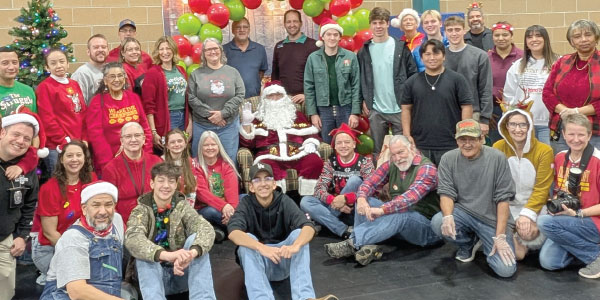
By Jorge Ramos
Time, or rather a lack of it, had always been the problem. The director Alfonso Cuarón wanted to make another film with Emmanuel Lubeski, the celebrated cinematographer and a close friend of his, known as “El Chivo,” but they wanted to do it at their own pace.
“If I had to pinpoint the greatest constraint we have in filmmaking,” Cuarón told me in an interview, “I’d say it’s time. So, when I decided to work on ‘Roma,’ I was determined to do it without any haste. It took me almost a year to prep, and it turned out to be my longest shoot.”
Ironically, it was because “Roma” required so much preparation that Lubeski — a three-time Oscar winner, for “Gravity” in 2013, “Birdman” in 2014 and “The Revenant” in 2015 — could not take part, since he had other commitments.
“‘Chivo’ is the best cinematographer alive, and the movie would’ve been even more beautiful had he been involved,” Cuarón said. “But I’m not sure it would’ve been more honest. See, I had direct access to my memories, and from my memories to the camera.”
When it came to recreating those memories, Cuarón was uncompromising. The production team had to obtain permission to use nearly 300 products that were popular in Mexico in the early 1970s in the film, from toys to cocoa powder, some of which no longer exist. Then the production designer, Eugenio Caballero, took on the nearly impossible task of putting the world inside Cuarón’s head on film.
To shape his film, Cuarón explored memories of his childhood in Mexico City’s Roma neighborhood. His crew managed to build a hospital set in the film with reclaimed sinks, doors and tiles, and similar efforts went into recreating Cuarón’s childhood street. “Eugenio had to build up facades on top of existing ones, because they had been revamped,” Cuarón said. Scenes related to the Corpus Christi massacre of student demonstrators in Mexico City in 1971 were shot on location, including scenes in what used to be a furniture store. The filmmakers recreated other pieces of Mexico City, such as the intersection where the Las Americas movie theater sat.
“Which of the boys from the film is you?” I asked Cuarón.
“I am the most obnoxious one, the middle child, the one who gets slapped in the face,” he said.
“And did you want him to look like you?” I asked.
“Yes, every character had to be played by someone who looked like them.”
Yalitza Aparicio — who stars as Cleo, the maid and the backbone of the family in “Roma” — plays the role of Libo, the Mixtec nanny who took care of Cuarón as a child.
“I never thought about acting,” Aparicio told me. She said her mother recalls how when she was younger she didn’t like having her picture taken, and was so shy that she wouldn’t talk to strangers.
Aparicio’s casting was very unusual. “It was in Tlaxiaco (in the state of Oaxaca, and very close to her home). My sister was personally invited to the casting because she is a singer,” Aparicio said. “But once there, she told me to take her place, because her pregnancy was a little risky.” And then Aparicio’s life changed forever.
“Yalitza is one of the most terrific actresses I’ve worked with,” Cuarón said. “It’s because she is such a sensitive and intelligent person.”
Delving so deeply into his memories was a mammoth task for Cuarón. “I don’t know if you can recover your childhood,” he said, “but I know you can come to terms with the scars left by your past.”
He did so in black and white, but employing the latest technology. Cuarón shot his movie in 65 mm film, using the most advanced audio system he could find. “It’s the most complex film ever made with the Dolby Atmos system,” he said. This is why he prefers that people watch the film in a theater, not on TV. “There is so much information in the background,” he said.
The attention to detail in “Roma” is amazing, and it’s why so many of us have found lost memories and lost loves within the film.
P.S. Break a leg at the Oscars, Alfonso, Yalitza, Marina de Tavira and all the “Roma” crew! Here is my podcast featuring the interview with Cuarón: bit.ly/2GnaJSX.
____________________________________________________________________________
‘Roma’ No Se Hizo en un Día
El problema es — y siempre lo ha sido — el tiempo. O, más bien, la falta de tiempo. El director Alfonso Cuarón, según me contó en una entrevista, se había sentado con su gran amigo, el director de fotografía Emmanuel “El Chivo” Lubeski, y querían hacer una película sin prisa.
“Hablando de lo que más nos limita en el cine”, me dijo Cuarón, “la cosa más limitante es el tiempo. Entonces, desde que decidí hacer ‘Roma’, decidí hacer una película donde no iba a tener consideraciones de tiempo. Preparé casi un año de tiempo de rodaje y es la película que he rodado por más tiempo”.
La ironía es que, precisamente por todo el tiempo que ‘Roma’ se iba a tomar, “El Chivo” Lubeski — ganador de tres Óscares por mejor fotografía en “Gravity” (2013), “Birdman” (2014) y “The Revenant” (2015) — ya no pudo participar. Tenía otros compromisos.
“‘El Chivo’ es el mejor fotógrafo vivo”, reconoció Cuarón, y con él “la película hubiese sido más bella. Lo que no estoy seguro es si hubiera sido más verdadera. Lo que sucedió es que yo tenía acceso directo a mis memorias; y de mis memorias a la cámara”.
Fue implacable con sus recuerdos. Se pidieron permisos para usar cerca de 300 marcas de la época — desde juguetes hasta chocolate en polvo — algunas de las cuales ya ni siquiera existían. Además, el diseñador de producción, Eugenio Caballero, tuvo la casi imposible tarea de recrear lo que había en la cabeza de Cuarón.
Así, recuperando lavabos, puertas y mosaicos de principios de los 70, se reinventó el centro médico que aparece en la película. También la calle de la infancia de Cuarón. “Eugenio tuvo que construir fachadas encima de fachadas porque ya estaban modernizadas”, me dijo. La locación donde se ve la represión de “Los Halcones” contra estudiantes es en el mismo lugar donde antes había una mueblería. Y reconstruyeron partes de la ciudad de México, como el cruce de Insurgentes y el cine Las Américas.
Había que rascar en los recuerdos de la ciudad y en los de su infancia en la colonia Roma (por eso el nombre de la película).
¿Cuál de los niños eras tú en la película? le pregunté. “Yo soy el niño más insoportable, el segundo, al que le dan la cachetada”. ¿Y querías que se pareciera a ti? “Sí, es que todos se tenían que parecer a la gente original”.
Ese es el caso de la actriz Yalitza Aparicio, quien protagoniza el personaje de Cleo, una empleada doméstica en la casa de una familia de clase media. Con extraordinario talento, Yalitza interpreta a Libo — la mujer que cuidó a Cuarón cuando era niño — y se convierte en el eje central del film.
Actuar “nunca se me había pasado por la cabeza”, me contó la actriz de origen mixteco en una conversación. Su mamá le recuerda que, más joven, no se dejaba tomar fotos y le daba pena hablar con desconocidos.
Su “casting” fue muy inusual. Así me lo contó Aparicio: “El casting se hizo en Tlaxiaco [en el estado de Oaxaca y muy cerca de su casa]. A este casting se le hace la invitación directamente a mi hermana porque ella se dedica a cantar … Pero al estar ahí, ella me pide que pase [porque] se encontraba algo delicada con su embarazo». Y así cambió su vida para siempre. “Yalitza es una de las actrices más completas y tremendas con las que he trabajado”, reconoció Cuarón, “y tiene que ver con su sensibilidad y su inteligencia».
El trabajo — titánico — fue escarbar en la mente del director. “¿Sabes?” me contó Cuarón, “yo no sé si las infancias se recuperan. Lo que sí es que puedes llegar a tener buenos términos con las cicatrices que se crearon en el pasado».
Y lo hizo en blanco y negro. Pero con la tecnología más moderna. La rodó con una cámara de 65 milímetros y el más avanzado sistema de audio. “Es la película más compleja que jamás se haya hecho con el sistema Dolby Atmos”, me dijo. Por eso prefiere que la gente vea la película en el cine y no en un televisor. “Hay mucha información que está dada en los fondos».
Así, con ese extraordinario cuidado por el detalle, es como se hizo “Roma». Por eso tantos estamos buscando — y encontrando — en esa película el tiempo y el amor que se nos fue de las manos.
Posdata. “Break a leg” en los Óscares, Alfonso, Yalitza, Marina de Tavira y todo el equipo de “Roma.” Y aquí está mi podcast con Cuarón: bit.ly/2GnaJSX.










